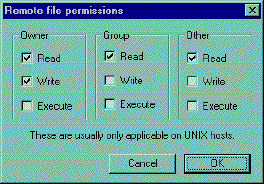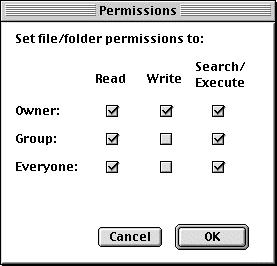- Setting
Permissions
- Permission
Definitions
- Setting
Permissions Using CuteFTP for Windows
- Setting
Permissions Using WS_FTP for Windows
- Setting
Permissions Using Fetch For MAC
Back to Support
menu
- Setting Permissions
You can use two different ways to set permissions for your files and directories
within your account.
1) FTP, and 2) SSH/Telnet.
-
Permission Definitions
Owner = the files users (you)
Group = the files group
Others = others
Permissions Definitions:
r = read access
x = execute access
w = write access
Numerical Definitions:
r = 4
x = 2
w = 1
You will come to recognize, if you do not already, Chmod as a word used for
changing
Permissions from within Telnet or your FTP client.
Most scripts will tell you to chmod 775. When using the numeric system, the
code for permissions is as follows:
4 + 2 + 1 (rwx) = 7
The first number applies to Owner, the second number applies to Group, and
the third number applies to Others. Therefore the first 7 of the chmod 775
tells Unix to change the Owner's permissions to rxw (because r=4 + w=2 + x=1
adds up to 7, this giving the Owner Read, Write, and Execute Permission. The
second 7 applies to the group, this giving the Group Read, Write, and Execute
Permission, and the last number 5, refers to Others (4 + 1= 5), giving Others
only Read and Execute Permission. The permissions for chmod 775 look like
this: rwx rwx -rx.
Permissions are always broken up into three groups of letters, however if
there is a dash, this dash simply means that Permission wasn't given for that
particular function, for example in the chmod 775, Permission to Write was
not given to Others.
Remember: the first 3 letters always apply to Owner, the second 3 apply to
Group, and the third 3 apply to Others.
Note:
If you are in a hurry, simply give executable, read and write permission
to the owner and executable and read permission to the group and other. This
will work for most scripts.
Back
to Top
-
Setting Permissions Using CuteFTP for Windows:
Highlight the file you want to check, and right-click on it. A menu will pop
up, then select CHMOD. You will see the window as shown below in the screenshot
we've provided. Click on the appropriate settings as needed. (Refer to the
Permission Definitions
for an explanation of settings.

Back to Top
-
Setting Permissions Using WS_FTP for Windows:
This is similar to using CuteFTP. Highlight the file you want to check, and
right-click on it. A menu will pop up, then select CHMOD. You will see the
window as shown below in the screenshot we've provided. Click on the appropriate
settings as needed. (Refer to the Permission
Definitions for an explanation of settings)

Back to Top
-
Setting Permissions using Fetch for MAC:
Go to the file you want to change the permissions on, and highlight it. Under
the Remote menu, select Change Permissions. A window will pop up showing the
current permissions for the file you had highlighted, as shown in the screenshot
below. Click on the boxes to change permissions as needed. (Refer to the Permission
Definitions for an explanation of settings)

Back to Top
Back
to Support menu
|




